Josipa Petric1*, Roland Deek1, Neil Kruger2, Melanie Amarasooriya3, John White4, Gregory I Bain5
1- Medical student, College of Medicine and Public Health, Flinders University, South Australia, Australia
2- Consultant Orthopaedic Surgeon, Base Hospital Diyatalawa and visiting lecturer, University of Colombo, Sri Lanka
3- Orthopaedic Research Unit, University of Cape Town, Groote Schuur Hospital, Cape Town, South Africa
4- Consultant Hand and Upper Limb Surgeon, Department of Orthopaedic and Trauma Surgery, Flinders Medical Centre, Adelaide, South Australia, Australia
5- Professor of Upper Limb and Research, Department of Orthopaedic and Trauma Surgery, Flinders University and Flinders Medical Centre, Adelaide, South Australia, Australia
*Corresponding Author: Josipa Petric, College of Medicine and Public Health, Flinders University, Flinders Drive, Bedford Park, 5042, Australia; Email: [email protected]
Published Date: 13-11-2020
Copyright© 2020 by Petric J, et al. All rights reserved. This is an open access article distributed under the terms of the Creative Commons Attribution License, which permits unrestricted use, distribution, and reproduction in any medium, provided the original author and source are credited.
Abstract
Introduction: The purpose of this study was to use 4D-CT to quantify the motion of the pisiform with relation to the triquetrum, in order to understand the piso-triquetral joint kinematics through active wrist movements. The use of 4D-CT allowed us to explore kinematic concepts objectively in a quantitative real-time manner, and has the advantage of visualisation in 6 degrees of freedom.
Materials and Methods: A normal wrist as was imaged through FE and RUD. Surface rendered models were created from individual carpal bones in each wrist position through the motion arc. These bones were tracked during RUD and FE using a registration algorithm. Radio-ulnar and flexion-extension motions of the pisiform and triquetrum, as well as the piso-triquetral distance were graphed against the global wrist motion.
Results: In wrist extension, the pisiform and triquetrum undergo more in-plane motion than the movement of the wrist, and are closest together. During flexion, the bones are furthest away from each other and exhibit out-of-plane (radioulnar deviation) motion in opposite directions. There is minimal out-of-plane motion during extension and during radioulnar deviation. During radioulnar deviation, the minimum articular distance between the pisiform and triquetrum changes negligibly.
Conclusions: These in vivo findings, although in a single patient, may be used for further characterisation of dynamic wrist pathology.
Keywords
Piso-Triquetral Joint; Pisiform; Carpal Kinematics; 4D-CT
Introduction
The pisiform is only carpal bone which is a complete tendon insertion site. Its functional significance is debated, whether it a simple sesamoid bone or carpal stabiliser. It is often compared to the patella in the knee. The pisiform alters the force trajectory of the Flexor Carpi Ulnaris (FCU) tendon according to wrist position. This serves as a lever to increase force during wrist flexion, and providing stability [1,2]. It is also constrained by various anatomical structures: the abductor digiti minimi quinti muscle, the piso-metacarpal ligament, the piso-hamate ligament, the extensor retinaculum, the piso-triquetral joint capsule, and a superficial fibrous band and transverse carpal ligament [1,3,4]. Despite this strategic placement of the pisiform in the wrist, pisotriquetral kinematics are poorly understood, particularly in-vivo.
The triquetrum is a key intercalated bone in the proximal row and is considered as the sensory organ of the wrist [5]. It articulates with the pisiform forming an ovoid piso-triquetral joint. Piso-triquetral joint pathology is a significant cause of ulnar-sided wrist pain [6,7].
Pisiform kinematic studies to date have been restricted due to the imaging constraints lacking the essential component in the definition: motion [1,8]. The use of 4D-CT allows dynamic real time observation of carpal motion in the clinical setting and can be used to inform the true kinematics of the pisiform. The radiation dose for a single scan is comparable to a 3D CT (0.31 mSv). The aim of this pilot study was to quantify the motion of the pisiform with relation to the triquetrum, in order to understand the piso-triquetral joint kinematics through active wrist movements using 4D CT. Below we have described the angulations and joint proximity of the pisiform and triquetrum during wrist extension to flexion, and ulnar to radial deviation.
Materials and Methods
Patients
A patient with normal wrist CT, MRI and arthroscopy was identified from a prospective database of patients with potential dynamic wrist pathology whom are referred from our institution (Institutional Review Board number: 6.20). The Digital Imaging and Communications in Medicine (DICOM) data for this patient was obtained and analysed.
4D-CT Imaging
A Siemens Somatom Force Dual source CT scanner was used to image the right wrist with an axial slice thickness of 0.6 mm and a helical sensitivity of 0.23 mm. The carpus was centred within the gantry (58.5 mm in width), and an initial scout image of the wrist in the neutral position was obtained. A scan sequence of 6-12 seconds, as the wrist moves, was acquired, at a rate of four frames per second. The output data was stored in the DICOM format.
Data Processing
The raw DICOM data was transferred to a medical imaging software program, 3D Slicer [8,9]. The imported data was converted to discrete 3D volumes at each acquired time point, which formed a 3D image sequence and model for each time point.
Individual STL files were then created for each of the individual carpal bones of interest (pisiform, triquetrum, radius and 3rd metacarpal) by segmentation and semi-automatic intensity thresholding. The frame in which the 3rd metacarpal axis aligned with the long axis of the radius was identified as the neutral reference frame.
As described by Wu et al., a full-length radius model was used as an anatomical coordinate system for the radius [10]. A registration algorithm allowed the partially visualised radius in the DICOM dataset to be aligned to the radius coordinate system, and subsequent manual correction achieved a complete 3D overlap. To account for the potential differences in orientation and position of the radius in the CT scanner, a comprised algorithm was used to align the co-ordinate system of the DICOM data set with the anatomical coordinate system of the radius [11,12].
Using the same algorithm, the rest of the radius models from all 12 frames were then positioned in the same co-ordinate system. This ensured that all movements were measured in term of the “fixed” radius to account for the effect of patient forearm movement during the scan. This therefore created a stationary platform for reference of the carpal bone motions.
Geospatial Carpal Bone Calculations
In the neutral frame position of the wrist, each carpal bone model had four fiducial markers placed. The fiducial markers, applied to the surface model of the bone, allowed for the tracking of the motion of the four specific points on the bone throughout wrist movement.
Fiducial markers were applied in the following order:- Markers A and C were placed at the end of the long axis of the bone (Fig. 1-3).
- Marker B was placed on the volumetric centroid of the bone.
- Marker D was placed on the surface of the bone, in a perpendicular line to the long axis, across point B.
The spatial position of each marker was obtained by its x, y and z coordinates. These were then tracked from the neutral position of the wrist to the extremes of wrist motion in radioulnar deviation and flexion-extension. Precision of the tracking algorithm was assessed with test and re-test repeatability of a Coefficient of Variance (CV) of less than 0.01 mm.
A custom-made program in Microsoft Excel 2019 allowed for the calculation of the angulations of the triquetrum and pisiform bones as a whole, based on the x, y, z coordinates of the four fiducial markers. The angle of the bone of interest at the neutral wrist position was considered as “zero” and the change of the angle was described from this position. Radioulnar angulation and flexion-extension of each bone was calculated during the wrist motions of flexion-extension and radioulnar deviation, using Euler angle principles. These angulations were graphed against wrist motion as a whole, depicted by the angle subtended by the radius and 3rd metacarpal.
In addition, the minimum articular distance between the pisiform and triquetrum were calculated and plotted against wrist motion.

Figure 1: Anatomical coordinate system of the radius – y axis is the mechanical axis of the radius. It is defined by point a and point b. Point a is the centre of the transverse section of the radius, at the level midway in a line joining point b and the geometric centre of the proximal radial articular surface (radial head). Point b is the dorso-volar midpoint of the ridge between the radio-scaphoid and radio-lunate facets. As the radius is only partially contained within our data set, the above model was aligned automatically onto the radius in the data set, and the same coordinate system was used to define the planes. Rotation around the x axis is defined as flexion and extension; Rotation around the z axis is radioulnar angulation and rotation around y axis is defined as prono-supination. A. Volar B. Radial C. Dorsal D. Ulnar views of the radius.

Figure 2: Volar view of the pisiform (orange) and triquetrum (green) in the neutral wrist position with A, B, C and D fiducial markers placed onto the STL files. B represent the centroid of the bone and the AC line, the long axis and D is marked on the surface of the bone, in a line perpendicular to AC, across B.

Figure 3: The piso-triquetral joint. I). volar view II). Ulnar view. The FCU tendon and hypothenar muscles via their attachments to the pisiform, mobilise the ulnar column of the carpus. I) FCU tendon attachment to pisiform. II) Triquetro-hamate joint is a flat biconcave joint. FCU: Flexor Carpi Ulnaris; TCL: Transverse Carpal Ligament; PML: Piso-Metacarpal Ligament; PHL: Piso-Hamate Ligament. (Copyright Melanie Amarasooriya, Gregory Bain)©
Results
Wrist Extension-Flexion
The wrist moved a total arc of 113◦ from extension to flexion: 60◦ of extension and 53◦ of flexion.
Extension-flexion of the Pisiform and Triquetrum (in-plane motion)
From wrist extension to flexion, both the pisiform and the triquetrum flex. The pisiform flexes 88◦ and the triquetrum flexes 72◦ in total. The motion is relatively linear throughout the wrist range (Fig. 4 and 5 and Table 1).

Figure 4: Wrist motion of extension to flexion – extension/flexion of pisiform and triquetrum. The x-axis shows the position of the wrist in degrees, and the y-axis shows the angulation of the pisiform and triquetrum in degrees. The zero positions of the bones are when the wrist is in neutral. Both the triquetrum and pisiform flex, the pisiform more than the triquetrum. There is a relatively smooth motion of both the pisiform and triquetrum.

Figure 5: Wrist extension to flexion – angulation of pisiform and triquetrum. The volar and distal views show the in-plane pisiform motion as it moves with the direction of the wrist. The ulnar view show more clearly the piso-triquetral distance as it increases from neutral to extension and neutral to flexion.
|
Bone |
Extension to Neutral |
Neutral to Flexion |
Total |
|
*Extension/flexion of the pisiform and triquetrum |
|||
|
3rd Metacarpal |
60 |
53 |
113 |
|
Pisiform |
42 |
31 |
72 |
|
Triquetrum |
54 |
34 |
88 |
|
#Radioulnar angulation of the pisiform and triquetrum |
|||
|
Pisiform |
-9 |
-38 |
-47 |
|
Triquetrum |
1 |
27 |
28 |
|
All measurements are in degrees. *Flexion is (+’ve); extension is negative (-‘ve). # Ulnar is positive (+’ve); radial is negative (-‘ve). |
|||
Radioulnar Angulation of the Pisiform and Triquetrum (out-of-plane motion)
From wrist extension to neutral the triquetrum angulates minimally (<1◦) and the pisiform radially deviates 9◦. From neutral to flexion, the pisiform and triquetrum angulate in opposite directions: the pisiform angulates 38◦ radially and the triquetrum ulnarly angulates 28◦ (Fig. 5 and 6 and Table 1).

Figure 6: Wrist motion of extension to flexion – radioulnar angulation of the pisiform and triquetrum. Both the triquetrum and pisiform show minimal angulation from extension to neutral and do not change positions. During flexion, the pisiform and triquetrum show out-of-plane motion: the pisiform angulates 38◦ radially whilst the triquetrum angulates 28◦ ulnarly.
Piso-triquetral Distance
The minimum articular distance between the pisiform and triquetrum changes negligibly, from wrist extension to neutral. As the wrist flexes, the distance progressively increased to 2.5 mm (Fig. 7).

Figure 7: Extension to flexion – the piso-triquetral distance. The x-axis shows the position of the wrist in degrees, and the y-axis shows the piso-triquetral distance in millimetres (mm). From extension to neutral, there is minimal change. From neutral to flexion, the piso-triquetral distance increased to 2.5 mm.
Wrist Ulnar-Radial Deviation
The wrist moved an arc of 53◦ from ulnar to radial deviation: 23◦ of ulnar deviation and 30◦ of radial deviation.
Extension-flexion of the Pisiform and Triquetrum (in-plane motion)
The pisiform and triquetrum angulate negligibly from ulnar deviation to neutral. From neutral to radial deviation, the triquetrum then flexes 10◦ and the pisiform extends 8◦ in full wrist radial deviation. The out-of-plane motion of both bones is small compared to the in-plane motion of the wrist (Fig. 8 and 9 and Table 2).

Figure 8: Wrist motion of ulnar to radial deviation – extension/flexion of pisiform and triquetrum. The triquetrum flexes, whilst the pisiform shows minimal angulation except for extension in terminal radial deviation. There is a relatively minor amount of motion, compared to the motion of the wrist.

Figure 9: Ulnar to radial deviation – angulation of pisiform and triquetrum.
The volar and ulnar view show the triquetrum follow the in-plane motion of the wrist, whilst the pisiform has minimal angulation from ulnar deviation to radial, and shows terminal radial deviation and extension. The distal view shows minimal changes throughout the motion.
|
Bone |
UD to Neutral |
Neutral to RD |
Total |
|
*Extension/flexion of the pisiform and triquetrum |
|||
|
Pisiform |
1 |
-9 |
-8 |
|
Triquetrum |
4 |
10 |
14 |
|
#Radioulnar angulation of the pisiform and triquetrum |
|||
|
3rd Metacarpal |
-23 |
-30 |
-53 |
|
Pisiform |
-3 |
-12 |
-15 |
|
Triquetrum |
-14 |
-11 |
-25 |
|
All measurements are in degrees. *Flexion is (+ve); extension is negative (-ve). # Ulnar is positive (+ve); radial is negative (-ve). |
|||
Radioulnar Angulation of the Pisiform and Triquetrum (out-of-plane motion)
The pisiform undergoes minimal angulation from wrist ulnar deviation to neutral but angulated 16◦ radially from neutral to wrist radial deviation. The triquetrum radially angulated 25◦ from wrist ulnar to radial deviation (Fig. 9 and 10 and Table 2).

Figure 10: Wrist motion of ulnar to radial deviation – radioulnar angulation of pisiform and triquetrum. Both the pisiform and triquetrum angulate radially, with triquetrum undergoing greater angulation. From -10◦ of wrist radial deviation to 10◦ there is minimal movement.

Figure 11: Radioulnar deviation – the piso-triquetral distance. From ulnar deviation to neutral, there is an increase in piso-triquetral distance of 0.3 mm. From neutral to radial deviation, the piso-triquetral distance decreased 0.5 mm.
Piso-triquetral Distance
The minimum articular distance between the pisiform and triquetrum changes negligibly, from ulnar to radial deviation, the change being less than 1 mm (Fig. 11).
Discussion
Wrist Extension-Flexion
From extension to flexion of the wrist, the in-plane motion (extension/flexion) of the triquetrum and pisiform was considerably more than the out-of-plane motion (radioulnar angulation).
Extension-flexion of the Pisiform and Triquetrum
From extension to flexion, both the triquetrum and pisiform undergo a similar degree of motion, angulating 72◦ and 88◦ respectively, moving linearly. The pisiform angulates a total of 16◦ more than the triquetrum. The greater arc of motion for both the pisiform and the triquetrum was during extension to neutral compared to from neutral to flexion. The pisiform extends 20◦ more during wrist extension than it flexes during wrist flexion, and the triquetrum extends 12◦ more than it flexes. This is more pronounced than the in-plane motion of the wrist, which only showed 7◦ more angulation during extension. The comparatively smaller motion of the triquetrum may be accounted for by the position of the pisiform as a stabiliser, which prevents subluxation of the triquetrum in extreme extension [3].
Radioulnar Angulation of the Pisiform and Triquetrum
From extension to flexion, the pisiform angulates radially and the triquetrum ulnarly. The pisiform angulates 20◦ more than the triquetrum during this motion. The majority of this out-of-plane motion occurred during the arc from neutral to flexion. Moojen et al., postulated that this was likely due to the FCU pulling the pisiform during wrist flexion, with the comparatively smaller motion of the triquetrum due to it being rigidly bound to the proximal carpal row [1]. However, the degree of radial angulation is limited by the ulnar pisotriquetral ligament [8].
Piso-triquetral Distance
During wrist extension there was minimal change in the piso-triquetral distance, although this distance increased by 2.5 mm from neutral to flexion. Yamaguchi, et al., using cineradiography, found that the pisiform moved away from the triquetrum during flexion, and that it compressed against the triquetrum during extension [13]. These findings are further supported by Jameson, et., who used scout films instead and also measured the piso-triquetral distance [14]. Four-dimensional CT has previously been used to assess carpal dyskinematics, with a focus on scapholunate instability in particular, using descriptive methods [15]. It is becoming an important diagnostic tool for dynamic wrist pathology and has unmasked abnormal joint motion and instability during physiological motion and loading with a clenched fist [16]. Our technique utilised 4D-CT throughout the motion arc of full extension to full flexion in-vivo. It allowed us to explore kinematic concepts objectively in a quantitative real-time manner, and has the advantage of visualisation in 6 degrees of freedom, capturing the natural wrist motion with higher spatial and temporal resolution [17]. This technique allowed us to explore more accurately the in-plane and out-of-plane motion of the entire pisiform and triquetrum in individual arcs, with a sensitivity of up to 0.25 s and a resolution of up to 0.23 mm [16].
Potential challenges with 4D-CT technology arise when patients are free to move, and unwanted radius movements occur. We managed this by aligning all radii to the neutral frame which was a patient specific ‘functional neutral,’ whereby the wrist was in slight extension rather than absolute neutral.
Wrist Ulnar-Radial Deviation
From ulnar to radial deviation of the wrist, the in-plane motion (radioulnar angulation) of the triquetrum and pisiform was considerably more than the out-of-plane motion (flexion/extension).
Extension-flexion of the Pisiform and Triquetrum
The triquetrum exhibits 5◦ more out-of-plane motion than the pisiform to reach a total of 14◦ of flexion; most of this motion occurs during radial deviation. This occurred because the triquetrum is well bound to the proximal carpal row and flexes with the scaphoid and lunate in radioulnar deviation [18]. The pisiform shows angulation only during terminal radial deviation, when it extends 9◦. During maximal radial deviation of the wrist, the FCU does not contract. Therefore, the pisiform is not under the flexion moment of the FCU, which results in this extension during radial deviation.
Radioulnar Angulation of the Pisiform and Triquetrum
During wrist ulnar to radial deviation, the triquetrum exhibits 3◦ more in-plane movement during ulnar deviation than radial deviation, and deviates 11◦ more ulnarly than the pisiform. The pisiform angulates in-plane 9◦ more during radial deviation than ulnar deviation, and angulates 2◦ more radially than the triquetrum. The triquetrum is more dynamic throughout the motion as it angulates 9◦ more than the pisiform in total. With ulnar deviation, the triquetrum extends slightly, and deviates more ulnarly than the pisiform [1]. Demehri et al., using 4D CT, found that there is also a distal translation of the pisiform during radial deviation and during wrist extension [6].
Piso-triquetral Distance
The piso-triquetral articular distance was found minimally change as the wrist ranged from ulnar to radial deviation. The articular surface of the piso-triquetral joint is nearly parallel to the radio ulnar plane. We contend that when the wrist moves in the radioulnar plane with minimum out-of-plane motion of the bones, the articular surface distance remains relatively static.
This pilot study included a mechanically normal wrist, with a focus on quantifying pisotriquetral kinematics using 4D-CT technology. Although the generalisability of this study is limited by the use of one patient, it was successful in assessing the validity of a novel approach to capture wrist kinematics in-vivo. Further studies utilising greater participant numbers, and through the approach outlined in this pilot study, may gain greater insight into variations in both normal and abnormal wrist kinematics.
Conclusion
This 4D CT scan pilot study demonstrated that the piso-triquetral joint is a dynamic structure with significant in-plane and out-of-plane motion dependent on the wrist’s direction of movement. Additionally, in using 4D CT to understand normal wrist dynamics, it is becoming an important diagnostic tool for dynamic wrist pathology.
Acknowledgments
We would like to thank Dr Kimberley Bryant for her assistance and guidance in this research.
References
- Moojen TM, Snel JG, Ritt MJ, Venema HW, den Heeten GJ, Bos KE. Pisiform kinematics in-vivo. J Hand Surg Am. 2001;26(5):901-7.
- Shulman BS, Rettig M, Sapienza A. Management of Pisotriquetral Instability. J Hand Surg Am. 2018;43(1):54-60.
- Beckers A, Koebke J. Mechanical strain at the pisotriquetral joint. Clinical Anat. 1998;11(5):320-6.
- Paley D, McMurtry RY, Cruickshank B. Pathologic conditions of the pisiform and pisotriquetral joint. J Hand Surg Am. 1987;12(1):110-9.
- Hagert E, Garcia-Elias M, Forsgren S, Ljung BO. Immunohistochemical analysis of wrist ligament innervation in relation to their structural composition. J Hand Surg Am. 2007;32(1):30-6.
- Demehri S, Wadhwa V, Thawait GK, Fattahi N, Means KR, Carrino JA, et al. Dynamic evaluation of pisotriquetral instability using 4-dimensional computed tomography. J Comput Assist Tomogr. 2014;38(4):507-12.
- Lautenbach M, Eisenschenk A, Langner I, Arntz U, Millrose M. Comparison of clinical results after pisiformectomy in patients with rheumatic versus posttraumatic osteoarthritis. Orthoped. 2013;36(10):e1239-43.
- Rayan GM, Jameson BH, Chung KW. The pisotriquetral joint: anatomic, biomechanical, and radiographic analysis. J Hand Surg Am. 2005;30(3):596-602.
- Fedorov A, Beichel R, Kalpathy-Cramer J, Finet J, Fillion-Robin JC, Pujol S, et al. 3D Slicer as an image computing platform for the Quantitative Imaging Network. Magn Reson Imaging. 2012;30(9):1323-41.
- 2012 http://www.slicer.org [Last accessed on November 15, 2020].
- Wu G, Van der Helm FC, Veeger HD, Makhsous M, Van Roy P, Anglin C, et al. ISB recommendation on definitions of joint coordinate systems of various joints for the reporting of human joint motion-Part II: shoulder, elbow, wrist and hand. J Biomech. 2005;38(5):981-92.
- Kobayashi M, Berger RA, Nagy L, Linscheid RL, Uchiyama S, Ritt M, et al. Normal kinematics of carpal bones: a three-dimensional analysis of carpal bone motion relative to the radius. J Biomech. 1997;30(8):787-93.
- Yamaguchi S, Nagao T, Beppu M, Tuda A, Miyoshi K. Pisotriquetral joint-anatomy and movement. J Jpn Soc Surg Hand. 1992;9:25-8.
- Jameson BH, Rayan GM, Acker RE. Radiographic analysis of pisotriquetral joint and pisiform motion. J Hand Surg Am. 2002;27(5):863-9.
- Garcia-Elias M, Alomar Serrallach X, Monill Serra J. Dart-throwing motion in patients with scapholunate instability: a dynamic four-dimensional computed tomography study. J Hand Surg Eur. 2014;39(4):346-52.
- Carr R, MacLean S, Slavotinek J, Bain GI. Four-dimensional computed tomography scanning for dynamic wrist disorders: prospective analysis and recommendations for clinical utility. J Wrist Surg. 2019;8(2):161-7.
- Rauch A, Arab WA, Dap F, Dautel G, Blum A, Gondim Teixeira PA. Four-dimensional CT analysis of wrist kinematics during radioulnar deviation. Radiology. 2018;289(3):750-8.
- Kobayashi M, Berger RA, Linscheid RL, An KN. Intercarpal kinematics during wrist motion. Hand Clinics. 1997;13(1):143-9.
Article Type
Research Article
Publication History
Received Date: 22-10-2020
Accepted Date: 13-11-2020
Published Date: 21-11-2020
Copyright© 2020 by Petric J, et al. All rights reserved. This is an open access article distributed under the terms of the Creative Commons Attribution License, which permits unrestricted use, distribution, and reproduction in any medium, provided the original author and source are credited.
Citation: Petric J, et al. Assessment of the Piso-Triquetral Kinematics-A Pilot Study Using Dynamic CT. J Ortho Sci Res. 2020;1(1):1-16.

Figure 1: Anatomical coordinate system of the radius – y axis is the mechanical axis of the radius. It is defined by point a and point b. Point a is the centre of the transverse section of the radius, at the level midway in a line joining point b and the geometric centre of the proximal radial articular surface (radial head). Point b is the dorso-volar midpoint of the ridge between the radio-scaphoid and radio-lunate facets. As the radius is only partially contained within our data set, the above model was aligned automatically onto the radius in the data set, and the same coordinate system was used to define the planes. Rotation around the x axis is defined as flexion and extension; Rotation around the z axis is radioulnar angulation and rotation around y axis is defined as prono-supination. A. Volar B. Radial C. Dorsal D. Ulnar views of the radius.

Figure 2: Volar view of the pisiform (orange) and triquetrum (green) in the neutral wrist position with A, B, C and D fiducial markers placed onto the STL files. B represent the centroid of the bone and the AC line, the long axis and D is marked on the surface of the bone, in a line perpendicular to AC, across B.
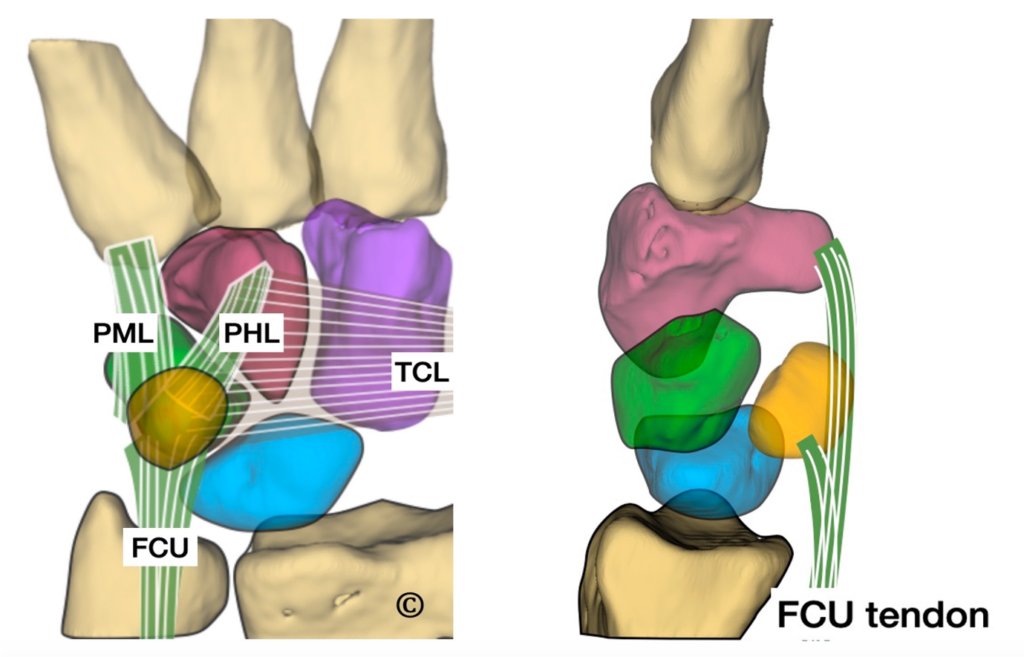
Figure 3: The piso-triquetral joint. I). volar view II). Ulnar view. The FCU tendon and hypothenar muscles via their attachments to the pisiform, mobilise the ulnar column of the carpus. I) FCU tendon attachment to pisiform. II) Triquetro-hamate joint is a flat biconcave joint. FCU: Flexor Carpi Ulnaris; TCL: Transverse Carpal Ligament; PML: Piso-Metacarpal Ligament; PHL: Piso-Hamate Ligament. (Copyright Melanie Amarasooriya, Gregory Bain)©

Figure 4: Wrist motion of extension to flexion – extension/flexion of pisiform and triquetrum. The x-axis shows the position of the wrist in degrees, and the y-axis shows the angulation of the pisiform and triquetrum in degrees. The zero positions of the bones are when the wrist is in neutral. Both the triquetrum and pisiform flex, the pisiform more than the triquetrum. There is a relatively smooth motion of both the pisiform and triquetrum.
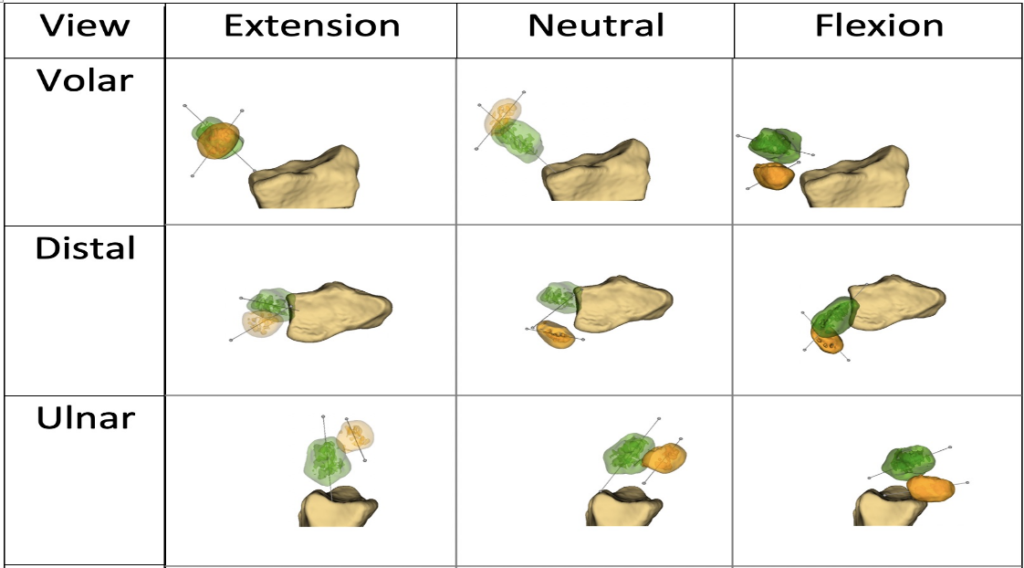
Figure 5: Wrist extension to flexion – angulation of pisiform and triquetrum. The volar and distal views show the in-plane pisiform motion as it moves with the direction of the wrist. The ulnar view show more clearly the piso-triquetral distance as it increases from neutral to extension and neutral to flexion.
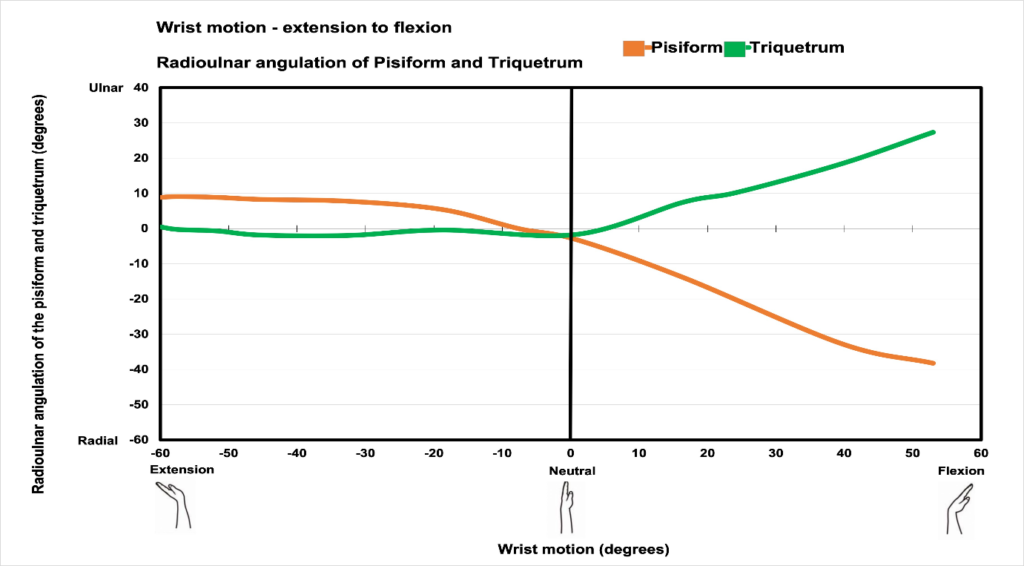
Figure 6: Wrist motion of extension to flexion – radioulnar angulation of the pisiform and triquetrum. Both the triquetrum and pisiform show minimal angulation from extension to neutral and do not change positions. During flexion, the pisiform and triquetrum show out-of-plane motion: the pisiform angulates 38◦ radially whilst the triquetrum angulates 28◦ ulnarly.
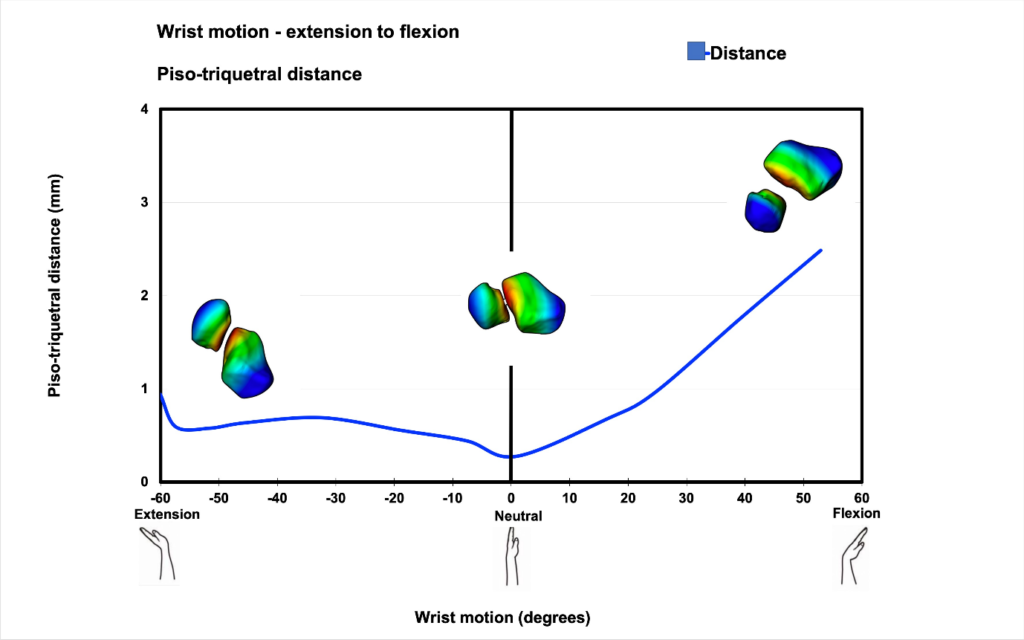
Figure 7: Extension to flexion – the piso-triquetral distance. The x-axis shows the position of the wrist in degrees, and the y-axis shows the piso-triquetral distance in millimetres (mm). From extension to neutral, there is minimal change. From neutral to flexion, the piso-triquetral distance increased to 2.5 mm.
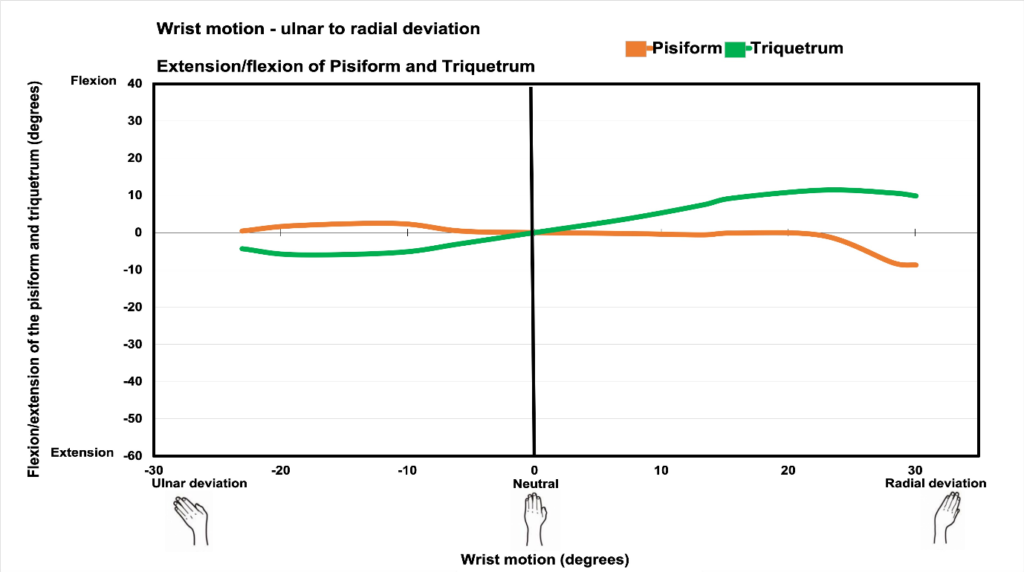
Figure 8: Wrist motion of ulnar to radial deviation – extension/flexion of pisiform and triquetrum. The triquetrum flexes, whilst the pisiform shows minimal angulation except for extension in terminal radial deviation. There is a relatively minor amount of motion, compared to the motion of the wrist.
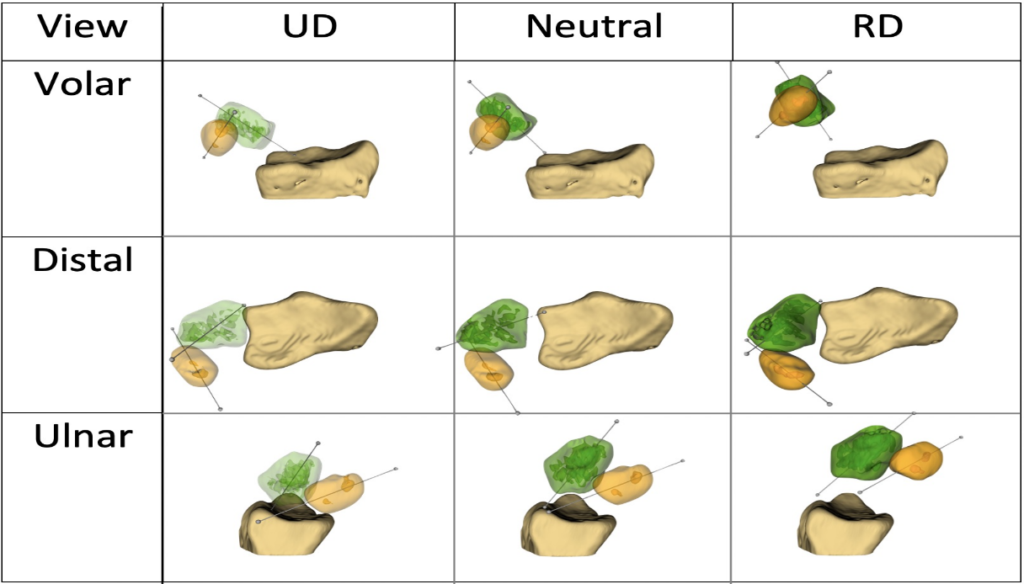
Figure 9: Ulnar to radial deviation – angulation of pisiform and triquetrum.
The volar and ulnar view show the triquetrum follow the in-plane motion of the wrist, whilst the pisiform has minimal angulation from ulnar deviation to radial, and shows terminal radial deviation and extension. The distal view shows minimal changes throughout the motion.
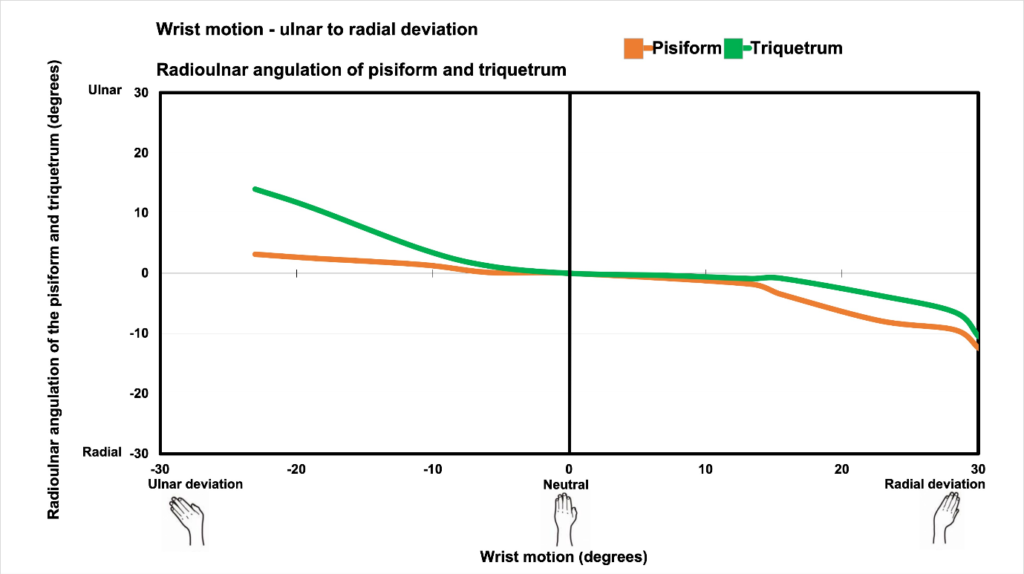
Figure 10: Wrist motion of ulnar to radial deviation – radioulnar angulation of pisiform and triquetrum. Both the pisiform and triquetrum angulate radially, with triquetrum undergoing greater angulation. From -10◦ of wrist radial deviation to 10◦ there is minimal movement.
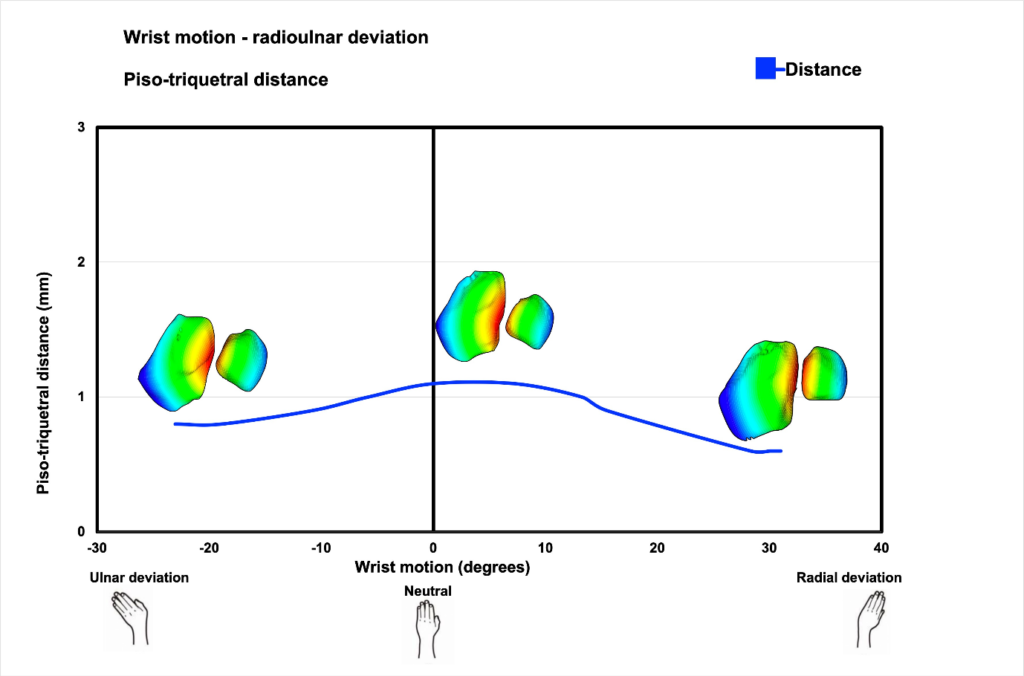
Figure 11: Radioulnar deviation – the piso-triquetral distance. From ulnar deviation to neutral, there is an increase in piso-triquetral distance of 0.3 mm. From neutral to radial deviation, the piso-triquetral distance decreased 0.5 mm.
Bone | Extension to Neutral | Neutral to Flexion | Total |
*Extension/flexion of the pisiform and triquetrum | |||
3rd Metacarpal | 60 | 53 | 113 |
Pisiform | 42 | 31 | 72 |
Triquetrum | 54 | 34 | 88 |
#Radioulnar angulation of the pisiform and triquetrum | |||
Pisiform | -9 | -38 | -47 |
Triquetrum | 1 | 27 | 28 |
All measurements are in degrees. *Flexion is (+’ve); extension is negative (-‘ve). # Ulnar is positive (+’ve); radial is negative (-‘ve). | |||
Table 1: Wrist motion of extension to flexion.
Bone | UD to Neutral | Neutral to RD | Total |
*Extension/flexion of the pisiform and triquetrum | |||
Pisiform | 1 | -9 | -8 |
Triquetrum | 4 | 10 | 14 |
#Radioulnar angulation of the pisiform and triquetrum | |||
3rd Metacarpal | -23 | -30 | -53 |
Pisiform | -3 | -12 | -15 |
Triquetrum | -14 | -11 | -25 |
All measurements are in degrees. *Flexion is (+ve); extension is negative (-ve). # Ulnar is positive (+ve); radial is negative (-ve). | |||
Table 2: Wrist motion of ulnar to radial deviation.


